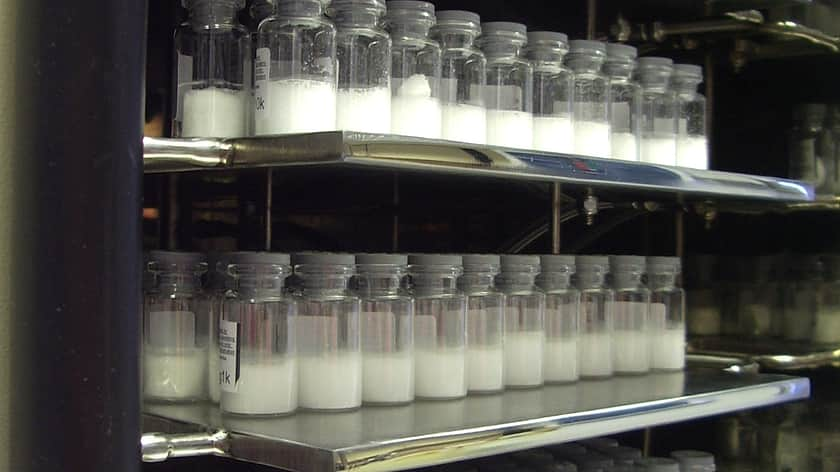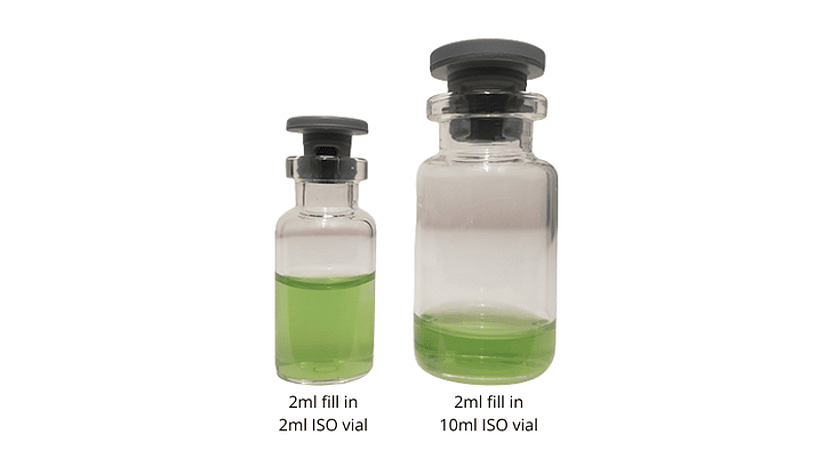Why do we freeze-dry pharmaceuticals?
Many pharmaceutical products stored in the liquid state are susceptible to degradation due to their physicochemical and thermostability characteristics, as well as sensitivity to external factors such as light, heat, and oxygen. Such products may become unstable, leading to a loss of efficacy. This creates a significant challenge for storage and logistics, and can have a detrimental effect on shelf life.
Lyophilization, or freeze-drying, is a process used in the pharmaceutical and biotech industries to stabilize a product by initially freezing the liquid state formulation and subsequently removing the water through a series of sublimation and desorption steps. The resulting dried state product, or “cake,” can typically be stored for longer periods of time at higher temperatures, substantially reducing the costs associated with shipping, transportation, and storage. The freeze-dried product may then be reconstituted with a diluent immediately prior to administration.
Lyophilization is of particular benefit for drug products that are unstable in liquid form as it is relatively gentle compared to other drying methods, enabling the stability and shelf life of the product to be increased with minimal risk to heat-labile products.
The freeze-drying process
There are three key stages to the freeze-drying process: freezing, primary drying, and secondary drying.
Freezing
During the first stage, the drug and its excipients are subjected to below-freezing temperatures until completely frozen. In this stage, the majority of water present forms a crystalline phase separate from the solutes, which typically remain in an amorphous state. Additional thermal treatment steps, such as annealing, may be employed to encourage ice crystal growth and networking or to promote crystallization of other formulation components to create a frozen state composition that is more favorable for freeze-drying.
Primary drying
The next stage is primary drying, in which the pressure in the chamber containing the frozen product is reduced to the point at which the ice present within the product sublimes to water vapor and escapes the vial. This vapor is subsequently deposited on a “condenser” located elsewhere in the freeze-dryer.
Secondary drying
In the final stage, the temperature of the product is increased to remove the remaining residual water by desorption. The dried powder remaining after the drying steps are complete is commonly known as a freeze-dried “cake.”
What to consider when freeze-drying within a vial
The optimal freeze-dry cycle is determined based on many factors, including your product’s unique characteristics and fill volume.
You may not be aware that your choice of vial and stopper can also have an impact on the success of your freeze-drying project.
Following are examples of some challenges you may face, and where the appropriate primary packaging choice can make all the difference.
Fogging
Fogging is an issue commonly encountered when freeze-drying. It presents as powder deposits on the inside walls of the vial, giving a “foggy” appearance to the glass, and occurs when residual liquid adheres to the internal surface of the vial prior to lyophilization. Antibody drug conjugates (ADCs) are especially liable to fogging during lyophilization.
Aside from being visually unappealing, and leading to rejections on a cosmetic defect basis, there are more serious implications to fogging.
The liquid clinging to the glass walls will have dried at a different rate than the solution at the bottom of the vial. It can be questioned whether this might affect quality and reconstitution behavior in the area of fogging compared to the lyo cake area.
Perhaps most serious of all, severe fogging that reaches the shoulder or neck of the vial may potentially compromise container closure integrity (CCI), which in turn calls into question the sterility of the finished drug product.

How can fogging be prevented?
The most effective solution to prevent or reduce fogging is to use a vial with a smooth, hydrophobic internal coating that will resist product creep, such as EVERIC® lyo vial.
Specially designed for freeze drying applications, the TopLyo® vial has a covalently bonded
Si-O-C-H internal surface, which repels liquid and helps the formation of a neat lyo cake.
For even greater protection we recommend the stopper used also features hydrophobic qualities.
West’s FluroTec® Freeze Drying stoppers benefit from an inert and hydrophobic FluroTec® lamination which prevents liquid from sticking to the plug area of the stopper.
Vials lifting in the freeze dryer
At the end of the freeze drying cycle the partially inserted stoppers are pressed fully home, typically using a built-in hydraulic stoppering mechanism that compresses the shelves together and enables stoppering of the vials without chamber aeration. When raising the shelves after compression, it is not uncommon for some rubber stoppers to remain temporarily stuck to the shelf, thus lifting the vial, which then drops and may result in breakage.
How do I prevent stoppers sticking to the freeze dryer shelves?
To prevent this from happening, pharmaceutical stopper manufacturers have developed stoppers with a non-stick top surface area.
West’s FluroTec® Freeze Drying stoppers benefit not only from FluroTec® lamination to the product-contact area, but also to the top of the stopper, providing a non-stick ETFE surface which will not adhere to the freeze dryer shelves.
The wrong vial size
It may seem logical to use a 2ml vial for a 2ml liquid fill. And that would be true if your product was intended to remain in liquid form. However, it is not ideal when the contents are to be freeze-dried.
Freeze-drying starts from the top down, and during the process a layer of dried product builds on top of the remaining frozen product. This dried layer presents a resistance to the flow of vapor being sublimated from the product, which becomes greater as the thickness of the dry layer increases.
Increased resistance to vapor flow results in a reduced sublimation rate and a decrease in the cooling effect experienced by the product due to sublimation. Not only does this decrease the efficiency of the drying process, but it may also lead to excess energy input to the product, increasing the temperature and potentially resulting in a collapse of the drying structure.
How do I know which vial size to use?
It is recommended that for freeze-drying in the vial, you have a maximum liquid fill depth of 12-15mm. You should use a vial with a large enough diameter to accommodate this.
We are happy to provide you with sample vials of different diameters for evaluation.

For more information on the role primary packaging plays in freeze drying, read our article Misconceptions in Freeze Drying.
Need help configuring your freeze-dry cycle? Lyophilization specialists, such as Biopharma Group, are on hand to help you optimize your formulation and process for success.
Commonly freeze-dried products include
- Vaccines and antibodies
- Cells and tissues
- Viruses and bacteria
- Proteins
- Enzymes
- Sera
